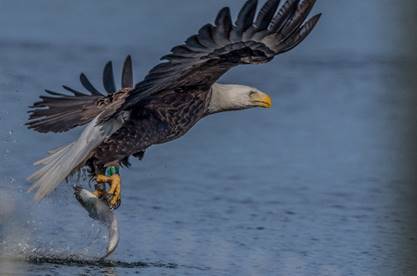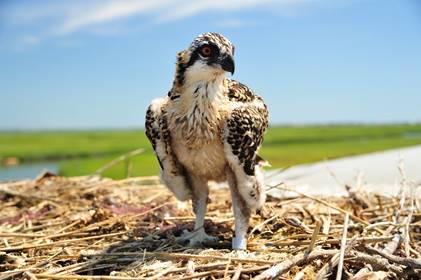The nonprofit
Conserve Wildlife Foundation of New Jersey (CWF) released the 2015 Bald Eagle Report this month, highlighting the number of nesting pairs, active nests and nest productivity for the raptors throughout New Jersey with data collected by New Jersey Department of Environmental Protection Division of Fish and Wildlife biologists, CWF biologists and committed volunteers.
"With 161 pairs of bald eagles this past year — up from just a single nest in the early 1980's — the dramatic ongoing recovery of bald eagles across the northeast continues to inspire so many of us," said David Wheeler, Conserve Wildlife Foundation Executive Director. "The thrill of seeing a bald eagle fly across the sky is unparalleled. This report captures how these eagles are continuing their All-American return."
The report notes that thirteen new eagle pairs were found this season, nine in the south, two in Central Jersey and two in Northern New Jersey.
With a wingspan of six to seven feet, bald eagles are larger than most birds. The bald eagle is restricted to North America and is usually found within close proximity to open water. In New Jersey, bald eagles reside year-round, usually remaining in the area surrounding their nest. They begin courtship and nest building in late December and January, adding to their existing nest. Over time, some nests can reach 10 feet across and weigh up to 2,000 pounds.
Conserve Wildlife Foundation partners with Duke Farms on a webcam that provides a live look at a bald eagle nest in Hillsborough, New Jersey. This spring, the EagleCam will allow viewers an up close and personal view into the lives of a pair of bald eagles as they breed, incubate, and raise young. Between the general public and classrooms up and down the east coast, the EagleCam has many fans – over 10 million viewers and growing!
The federal government removed the bald eagle from its list of Endangered Species in August of 2007, but the bald eagle’s official New Jersey status remains state-endangered for the breeding season and state-threatened for the non-breeding season.
"One of our encouraging findings is that the population of wintering bald eagles has grown along with the nesting population over the past decade," said Conserve Wildlife Foundation eagle biologist Larissa Smith. "This growth reflects the increasing populations in New Jersey and across the northeast, as recovery efforts continue to pay off for eagles. In addition to our fellow scientists in New Jersey and nearby states, I'd like to thank the wonderful eagle project volunteers who make keeping track of all these nests possible."
The Division of Fish and Wildlife’s Endangered and Nongame Species Program (ENSP) bald eagle recovery efforts, implemented in the early 1980’s, have resulted in a steady recovery of New Jersey’s bald eagle population. ENSP biologists, Conserve Wildlife Foundation of New Jersey staff, and volunteer observers continue to locate and monitor bald eagle nests and territories each year to analyze the state of the population. The state’s eagle population would not be thriving without the efforts of the dedicated eagle volunteers who observe nests, report sightings, and help protect critical habitat.
.jpg)
Conserve Wildlife Foundation of New Jersey (CWF) is a private, non-profit organization dedicated to the protection and preservation of New Jersey’s endangered and threatened wildlife and the habitats they depend on. We carry out our mission by researching and managing rare animal species, restoring habitat, educating New Jersey’s residents, and engaging volunteers in our conservation projects. Since the early 1990’s, CWF scientists and educators have helped conserve and protect a variety of at-risk species of wildlife in New Jersey, the most densely populated state in the nation.
Highlights of the 2015 New Jersey Bald Eagle Project Report are found below. To view the complete report online, visit
www.ConserveWildlifeNJ.org
2015 Report Highlights
- The statewide population increased to 161 territorial pairs in 2015, up from 156 last year.
- 13 new eagle pairs were found this season, nine in the south, two in central and two in northern New Jersey.
- 150 pairs were known active (meaning they laid eggs), up from 146 last year.
- 122 nests (81%) were known to be successful in producing 199 young, for a productivity rate of 1.33 young per known-outcome active nest, which is above the required range of 0.9-1.1 young per nest for population maintenance.
- One chick, orphaned from a Maryland nest, was fostered into a Cumberland County nest and fledged, bringing the total fledged to 200.
- 28 (19%) of nests failed to fledge young.
- The Delaware Bay region remained the state’s eagle stronghold, with 40% of all nests located in Cumberland and Salem counties.













.jpg)

